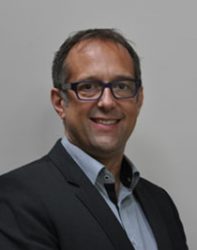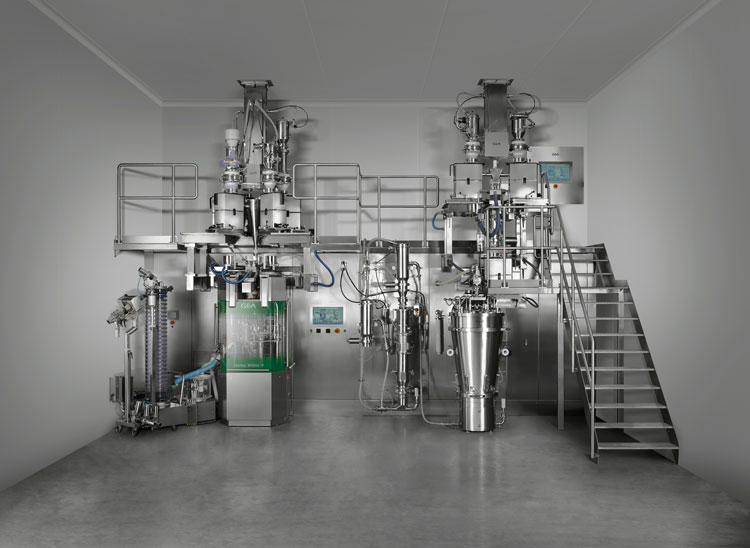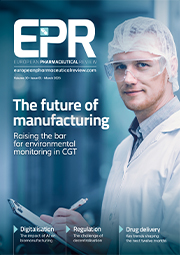Continuous Manufacturing Roundtable
Posted: 23 October 2018 | David Lovett (Perceptive Engineering Ltd), Dennis Powers - Vice President of Business Development & Sales Engineering G-CON Manufacturing Inc., Jan Verelst - Global Business Development Manager for SIPAT at Siemens, Marco Bellentani Product Manager for Containment and Innovative Solutions at MG2, Massimo Bresciani - R&D Executive Director for Business Development & Scientific Operation at RCPE, Richard Steiner - Business Development Manager for continuous oral solid dosage (OSD) systems at GEA | No comments yet
Welcome to European Pharmaceutical Review’s roundtable devoted to continuous manufacturing. We have brought together six industry experts to focus on how the contribution of continuous manufacturing technology is shaping the pharmaceutical sector and explain what factors are driving that change.


Participants:


Product Manager for Containment and Innovative Solutions, MG2


R&D Executive Director, Business Development and Scientific Operation, RCPE


Co-founder and Managing Director of Perceptive Engineering Ltd


Vice President of Business Development & Sales Engineering
G-CON Manufacturing, Inc.


Global Business Development Manager for SIPAT, Siemens


Business Development Manager for continuous oral solid dosage (OSD) systems, GEA
1. With pharma being so conservative, how can Conti pioneers convince the industry that this is the future of drug production?
Marco Bellentani: Conti pioneers should convince the industry that CM is the future of drug production by focusing on process understanding. In fact, continuous manufacturing provides a 360° view of the process to obtain uniformity of the content (the right formulation with the correct percentage of each ingredient), uniformity of the dosage (the right quantity of product inside each capsule), optimised quality performances (formulation designed to minimise variability of the process) and maximised efficiency (advanced controls and proper synchronisation).
All above results can be achieved in a fully integrated environment with CM suite and manufacturing equipment joint in a CM production system that works as a unique system.
All information collected by the components interacting in the CM system creates a sort of Big Data that can be analysed and used to define feedback and feedforward actions that allow continuous improvement of the process.
Massimo Bresciani: While pharma can appear to be more conservative in its adoption of novel technologies and new approaches to manufacturing, I don’t believe pharma is necessarily more conservative by choice. It is rather the interplay of different factors (and risk vs safety concerns) that make innovating the industry a challenge. As pioneers, it is our task to guide the industry through this transformational change by offering the right technology, ensuring the protection of patients, while fostering a new mindset. Ultimately, this is what RCPE has been doing for the past decade; allowing developers and operators to test and validate their ideas more rapidly to realise the intangible benefits that come along.
Dennis Powers: G-CON has worked closely with companies like Pfizer, GSK, and GEA to develop POD facility platform designs for continuous manufacturing of oral solid dosage products, including tablets and capsules, and incorporating the typical manufacturing processes such as wet and dry granulation, milling, and tablet coating. The POD designs also include support operations such as raw material handling, washing and storage as well as airlocks, for personnel, material, product, and waste flows. Integrated technical areas are also provided, which house the POD HVAC, mechanical, electrical and control systems as well as the process support equipment such as dust collection systems, vacuum transfer equipment, air handlers, CIP systems, etc.
Richard Steiner: By continuing to publicise their success stories and launch more and more NDAs based on CM process technologies. Also, by filing those products throughout global markets and supply chains, by building partnerships and developing standardised manufacturing platforms that deliver faster engagement and shorter project execution times. Last but not least, industry should invest in human resource initiatives to develop young professionals and provide them with the skillset to support change management.
Jan Verelst: It’s exactly here that the consortium brings added value: combining the vast functional and technical expertise of both GEA and Siemens leads to an increased offering of integrated, standardised solutions for PAT-enabled continuous manufacturing in pharma.
Where initially the integration of PAT tools on continuous manufacturing lines was carried out on a case-by-case basis for the different CM-projects, this approach has drastically changed in the last couple of years within the life sciences industry, and CM-lines are increasingly expected to come with an integrated PAT solution. This is where GEA and Siemens join forces to lower the threshold for pharma companies to step into the world of PAT-based continuous manufacturing.
2. Apart from cost, what other benefits will manufacturers derive from implementing Conti?
Marco Bellentani: One of the major benefits to be gained by the pharma industry adopting CM technology is the ability to obtain a small production of a few thousand capsules and a large production of millions of capsules with the same level of efficiency from the machine. The process itself is constantly monitored to immediately identify any variation in product characteristics, rejecting only the last fraction of blend produced. Therefore, small quantities of product are wasted, drastically increasing the overall yield of the process. Another big advantage is the possibility to use CM and the machine together in a sort of development mode to define the optimal formulation. In practice, CM suite can be used to automatically generate different concentrations of the ingredients and the machine with integrated 100% net weight control system can collect all measures. These measures can be analysed to identify the formulation that obtains the best performances in terms of process coefficient of variation. DOE (Design of Experience) can therefore be executed automatically and with the exact same configuration of the environment that will be used in production.
Massimo Bresciani: While decreased costs are a major advantage from a pure business perspective, we believe the real value of continuous manufacturing is the flexibility and ability to continuously monitor product quality. Moreover, processes can be developed much faster and with less risk. Continuous manufacturing needs to be considered in a wider context than production costs and supply chain. It offers pharmaceutical companies the opportunity to do more with fewer resources, effectively accelerating development. It thus provides better therapeutic options to patients and is sometimes an enabler for drug products that otherwise wouldn’t have seen the market due to their limited volume.
Dennis Powers: We have heard from clients that batch production of pre-clinical, clinical and commercial production is inefficient in that it requires different size equipment and different operators at each stage. Loss of knowledge and know-how occurs with each transition, leading to an inefficient process. In the continuous processes we have worked on, our partners required that we develop the process equipment and cleanroom environment to be able to handle each phase of the process such that the same operators will run the process from preclinical to commercial production. Such an approach is not only more cost efficient but is more time efficient as well and produces a more quality product.
Richard Steiner: Operational expenditure cost savings are not actually key focus points when it comes to CM benefits. There’s much more interest within the pharmaceutical sector in faster product development, expedited market launch and greater supply chain agility. What’s currently underestimated is the positive effect of CM on quality – in terms of both time and cost. It’s all about the OEE, which influences the ROI. It’s important at this stage to highlight certain country-specific differences; the arguments in favour of CM in high-cost geographies may not obtain in pharmerging economies. Nonetheless, we are seeing a great deal of interest in every major pharma market, worldwide.
Jan Verelst: The use of CM technologies and inline PAT monitoring is a key driver for building Quality by Design (QbD) into the complete product lifecycle – from R&D through to manufacturing – bringing safe medicines to market in a more efficient and cost-effective way.
Many pharmaceutical manufacturers are already converting their (OSD) processes to adopt continuous production: pharmaceutical products are produced in compact, integrated units, with a higher degree of automation and fewer manual interventions. Production steps that were performed sequentially in a classic batch process are integrated into a continuous train of process steps. Using in-line quality testing enables preventive quality monitoring, resulting in right-first-time production, therefore reducing waste products and eliminating the time typically spent on (end) product testing, quality evaluation and batch review.


Working together, GEA, Pfizer and G-CON formed a consortium to design and build a portable, continuous, miniature and modular (PCMM) platform for continuous OSD production using GEA’s ConsiGma® 25 equipment and G-CON’s modular POD system
3. Manufacturing requires more than just machinery; what does the collaboration offer that a single supplier can’t?
Marco Bellentani: The great advantage that collaboration can bring to customers is the capability of having a fully integrated system. A capsule filler and CM system are not just two systems that can be purchased independently and connected through a physical inlet pipe. An efficient and effective CM system requires a complete logical integration with the exchange of status, measures, and signals to maintain the process under control in all aspects, optimising the quality of the finished product and ensuring the safety of the process. Process parameters of the capsule filler can be automatically and continuously changed depending on the characteristics of the product prepared by the CM suite.
Massimo Bresciani: While machinery and equipment are crucial to manufacturing, they are merely the tangible. However, it is the fundamental understanding of processes, the behaviour of raw materials or intermediates, process parameters and their effects on the final products, as well as process dynamics, that affect the overall efficiency, and therefore the success, of manufacturing. The collaboration combines different players in the same industry and combines technology with research, to create one single direction of thrust; aligning work, adding complementary (and sometimes competitive) expertise to create a more comprehensive solution. This creates a single-source repository for pharmaceutical companies to benefit from the joint efforts.
Richard Steiner: GEA understands that implementing CM impacts many departments and disciplines within our clients’ organisations. At the same time, we appreciate that diversifying our service portfolio to meet requests that are beyond our core competencies is not feasible. With the experience gained during numerous projects, particularly regarding regulatory filings and financial business case assessments, we’ve encountered a variety of issues that are not part of our operational remit. So, we’re now co-operating with organisations such as RCPE, Accenture, Siemens and Perceptive Engineering (to name a few) to develop solutions together. At the same time, to support our clients we’re extending our portfolio of services to provide process analytical technology (PAT) software solutions, advanced process control and Industry 4.0 initiatives.
Jan Verelst: Introducing CM is not limited to the installation of a physical line. There are different aspects that come into play. It would be challenging to find a single supplier that can cover all these specialised aspects within its own offering. Active collaboration with providers of complementary technologies and solutions results in best-of-breed, standardised, off-the-shelf solutions with better integration. By collaborating with industry peers, suppliers can also lead the way towards smaller, more flexible CM technologies.
4. Describe how you see PAT and APC contributing to the continuous manufacture of solid drugs.
Marco Bellentani: Continuous manufacturing and PAT are in a real symbiosis. PAT tools such as NIR probes are crucial to constantly monitor the CQA of the product generated. These probes are installed in the whole CM line and MG2 has already identified different possible locations inside the capsule filler where additional probes could be installed. Moreover, a 100% integrated net weight control system that is available in all MG2 machines is another fundamental tool to understand the process. In this case, cumulative data, or even 100 percent of the measures collected by the system, can be transferred to the CM suite to be combined with the feeding data and NIR measurements to get a 360° picture of the process and be able to really understand and continuously improve it.
Massimo Bresciani: PAT and APC are the fundamental enablers of (full) continuous manufacture. Many advantages of CM depend on the ability to either assess the quality in real time in a process or at least predict the end result. PAT and APC help continuous manufacturing by expanding the knowledge space for manufacturing processes – and ultimately patient safety – by providing a better product. One cannot measure, assess and control what one does not understand. Therefore, it is imperative to reevaluate your understanding of processes and renew your approach to formulation, material science and process engineering.
David Lovett: Maintaining a continuous process at the desired state requires precise measurements and process adjustments to compensate for raw material fluctuations and process disturbances. With appropriate PAT to simultaneously measure multiple Critical Quality Attributes of the drug, such as API potency, homogeneity, weight, and hardness, a multivariable controller is required to control these interacting parameters. In these circumstances, it is beneficial to use a Model Predictive Control (MPC) system, which, by design, accounts for the interactions, the process residence times and the operating constraints within the system to provide the complete solution.
The “Advanced Process Control” techniques used in continuous pharmaceutical manufacturing typically include the MPC, soft sensors and a data integrity analyser. A multivariate statistical monitor is also often used to oversee the behaviour of all the system components – process, product, PAT and control system – checking each is working as expected. This integrated self-monitoring approach provides the CM system with the precision and robustness required for Continued Process Verification for GMP manufacture. This system is available on the GEA Consigma range.
Jan Verelst: Process Analytical Technology (PAT) and Advanced Process Control (APC) are crucial for continuous pharmaceutical manufacturing. The speed of manufacturing is so high that you cannot afford not to know what – at any point in time – the status of the quality is of what you are producing. It is therefore essential to allow for integrated product and process quality assessment to achieve real-time monitoring of product quality parameters (CQAs), ultimately completed with model-based control strategies.
5. How do you adapt to variable CM suite throughput?
Marco Bellentani: MG2 has different machine models to address specific customer requirements. Machines that best fit the CM paradigm are TEKNA, Planeta 100 and Planeta 200. All these machines have two ways to change the production speed and therefore to adapt perfectly to the CM suite throughput. The first method is to use the driver to increase and reduce the rotational speed. Typically, the speed can be reduced to half of the nominal speed. This manner of changing the speed is managed by the supervisory system controlling the whole line, to adjust the production capacity of the machine to be synchronised with the CM outlet. However, the nominal speed of the machine can also be adjusted by installing a different number of dosing elements. This method can be used, before starting production, to select the speed that best fits the CM throughput. Once the machine is fitted with a specific number of elements to obtain the desired nominal speed, the supervisory system will use the automatic speed variation as the function to ensure the whole line is properly synchronised. For example, Planeta 100 can run at 6,000 capsules/hour using just two dosators and can be scaled up to 100,000 capsules/hour using 32 dosators. Having the same dosing principles and same solutions for all machines helps to select the right configuration, depending on the specific needs of the customer. As a conclusion, MG2 machines can cover production capacity from 3,000 to 200,000 capsules/hour satisfying any required combination of CM throughput (eg, from 5 to 30kg/hour) and product dosage (eg, from 80 to 500mg of filling weight for each capsule).
Massimo Bresciani: In contrast to batch processing, adjusting throughput in a correctly configured CM line requires no scale-up or scale-down. The production volume for demand fluctuations – eg, due to regional events or patient demographic change – is adapted simply by changing the runtime. We envision that future generations of the CM equipment can even be designed to be miniaturised both in terms of default throughput and system footprint to facilitate parallel deployment and offer even more throughput and product matrix flexibility.
Dennis Powers: The POD’s modular plug and play design is well suited for future scalability and for adding additional capability as needed by installing additional PODs. The latest PCMM facility platform design has multiple configurations that can be installed at a client site depending on their product manufacturing needs. The PCMM base configuration incorporates continuous direct compression and tablet coating capability with the ability to “bolt on” additional PODs with wet granulation and encapsulation process operations as needed in the future. This modular facility design provides unparalleled flexibility for drug manufacturers who need the ability to more rapidly respond to changes in market demand for their products.
Richard Steiner: By applying a control regime that’s driven and orchestrated by the automated dispensing and blending system – based on Loss-in-Weight (LIW) feeding technology. The LiW feeder is the “master” in the control regime, whereas the downstream processes are the “servants,” right up until the coated tablet is finished. The ConsiGma® CDC 50 is a good example; the throughput rate can be as low as 2.5kg/h or as high as 130kg/h, depending on the application. Throughput scalability is one of the key advantages of CM processes. Validation strategies should be adapted to support continuous process verification and variable throughput rates, enabling the pharma industry to guarantee a more agile supply chain, avoid the risk of drug shortages and, most importantly, meet the unmet needs of patients.
6. Is this the end of batch?
Massimo Bresciani: No. A well-executed batch production will likely have economic benefits for specific applications, eg, fixed volume and sustainable patient population. In fact, successful CM deployment may be running in a so-called mini-batch mode.
Richard Steiner: Not at all. Any process technology has its technical limits and, even as the benefits of CM become more widely accepted, batch-based solutions are still the industry established standard. Furthermore, we’re aware of a significant amount of sometimes under-utilised batch equipment that needs to deliver a return on investment (ROI) within its depreciation schedule. Plus, generics manufacturers will only switch if there are process reliability and quality issues that enable them to optimise a specific unit operation. In another scenario, they may be able to use CM during the lifecycle management of an established OSD product.
Read more from our Spotlight on Continuous Manufacturing:
Taking a collaborative approach to continuous pharmaceutical manufacturing by Richard Steiner, GEA Group; on behalf of Accenture, G-CON, GEA, Leistritz, MG2, Perceptive Engineering, RCPE and Siemens
Making science work, GEA profile
Digital solutions for the pharmaceutical value chain, Siemens AG profile
Leading Prefabricated Cleanroom Designs, G-CON Manufacturing, Inc. profile
MG2 Capsule Fillers, MG2 S.r.l. profile
Your Process, Improved, Perceptive Engineering Limited profile
Better science for better products, Research Center Pharmaceutical Engineering GmbH profile
The rest of this content is restricted - login or subscribe free to access


Why subscribe? Join our growing community of thousands of industry professionals and gain access to:
- bi-monthly issues in print and/or digital format
- case studies, whitepapers, webinars and industry-leading content
- breaking news and features
- our extensive online archive of thousands of articles and years of past issues
- ...And it's all free!
Click here to Subscribe today Login here
Issue
Related topics
Related organisations
G-CON Manufacturing Inc., GEA, MG2, Perceptive Engineering Ltd, RCPE, Siemens









